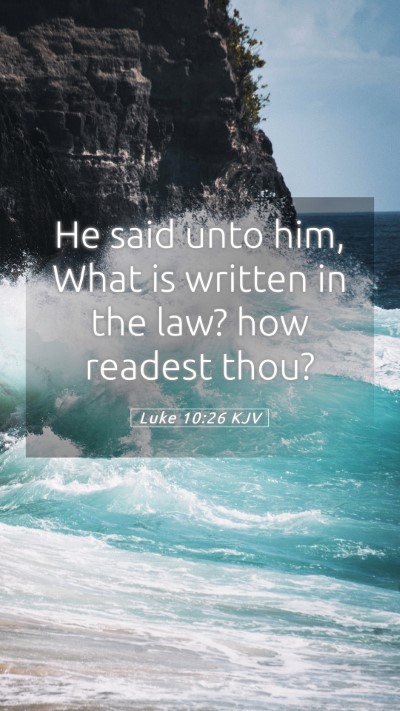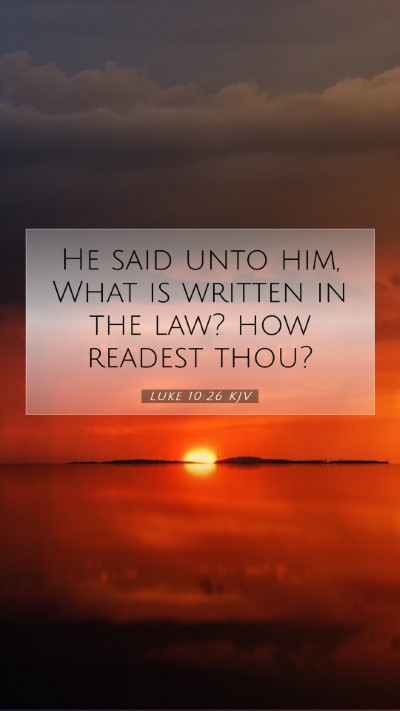Understanding Luke 10:26
Luke 10:26 states, "What is written in the Law? How do you read it?" This verse is part of a conversation between Jesus and a lawyer who sought to test Him regarding eternal life and the law.
Bible Verse Commentary
This verse plays an essential role in understanding how Jesus engages with the religious leaders of His time, emphasizing the importance of scriptural literacy and interpretation.
Matthew Henry's Commentary
According to Matthew Henry, this interaction illustrates the common practice of Jews in Jesus' day to rely on the Law of Moses as a foundation for their faith and way of living. He notes that the lawyer's question reveals a desire to understand legal and moral accountability. Jesus' response invites the lawyer not only to acknowledge the law but to reflect personally on its teachings.
Albert Barnes' Insights
Albert Barnes emphasizes that Jesus' question prompts the lawyer to direct himself back to the Scripture, reaffirming its authority. This also serves to engage the lawyer in self-examination, compelling him to seek an understanding that comes not merely from tradition but from actual engagement with the text of the Scriptures.
Adam Clarke's Interpretation
Adam Clarke discusses the cultural context of the Law in Jewish society, noting that the lawyer's question is typical of rabbinical debate. Clarke mentions that the phrase "How do you read it?" underscores the interpretive nature of scripture—it is not merely about reading but understanding and applying the Law.
Significance of the Verse
This verse serves as an introduction to deeper theological discussions concerning the nature of the law, the role of Jesus in the fulfillment of the law, and the significance of personal interpretation of Scripture.
Application to Daily Life
The question posed by Jesus challenges believers today to engage with Scripture actively and thoughtfully. It encourages a deeper exploration of biblical texts as tools for moral guidance and spiritual growth.
Bible Study Insights
- Understanding the importance of scripture in daily decisions.
- Recognizing the need for personal interpretation and application of biblical teachings.
- Realizing Jesus' authority in interpreting the law.
- Encouraging interactive Bible study groups to discuss difficult passages.
Bible Cross References
- Matthew 22:37-40: Jesus discusses the greatest commandment.
- Mark 12:28-31: The question about the greatest commandment is explored.
- John 5:39: Jesus encourages searching the Scriptures for eternal life.
Biblical Exegesis and Interpretation
As we delve into the exegesis of Luke 10:26, it's vital to understand that Jesus often utilized questions to provoke thought and reflection. His inquiry about the law was not merely a test of knowledge but a means to encourage the lawyer (and by extension, the readers) to consider the essence of true obedience and love derived from the law. The Law, as discussed in the Old Testament, demanded actions rooted in love toward God and neighbor.
Engaging in Online Bible Study
For those seeking to engage in online Bible studies or group lessons, Luke 10:26 offers a rich text to explore questions about the law, love, and moral behavior. Utilizing resources that provide historical context and interpretations can help facilitate deeper discussions.
Conclusion
Luke 10:26 invites readers to move beyond rote knowledge of the law and into a place of personal engagement with God's word. As an essential Bible verse meaning, it calls for introspection and a commitment to understanding Scripture in a way that is transformative and applicable to everyday life.


